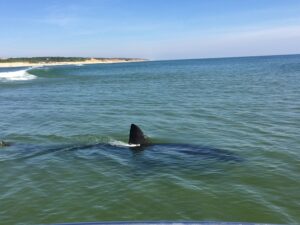WELLFLEET — Great white sharks have become as synonymous with Cape Cod summers as lobster rolls and bridge traffic. But as their population has rebounded after decades of decline, so have worries about the dangers of sharing the water with these migratory predators.

While there have been no injuries here since Arthur Medici’s lethal encounter with a shark in 2018, both town and National Park Service officials are working to prevent shark and human interactions by tracking the sharks’ numbers and movements to better understand their behavior and by educating people about the risks.
Craig O’Connell, a marine biologist who is not affiliated with any research institution but started his own nonprofit called O’Seas Conservation Foundation, based in Montauk, at the tip of New York’s Long Island, sees things differently. He is working on a shark barrier he thinks might be able to survive in turbulent Outer Cape waters.
This past September, O’Connell tested his creation off the coast of Chatham and said it maintained its integrity in five-foot swells during a four-day deployment. But he tested the barrier away from the turbulent sand and water conditions near the beach, instead erecting it further offshore.
So far, beach directors and shark experts are unconvinced of the effectiveness of the approach.
Linzy French, the public information officer for the Cape Cod National Seashore, wrote in an email that the Seashore does not currently consider barriers to be a viable mitigation method, but that they are not familiar with O’Connell’s design and remain open to learning about new technologies as they are tested.
Damion Clements, the director of community services in Truro who oversees the recreation and beach dept., said he has reached out to O’Connell about the device. He wrote in an email that he is not yet sure whether a shark barrier system could be viable in Truro, but he is “continually researching shark mitigation systems.”
At the same time, Clements sought advice from Gregory Skomal, senior fisheries biologist with the Mass. Dept. of Marine Fisheries and head of the Mass. Shark Research Program.
Skomal said he advised Clements that additional tests are needed.
The Atlantic waters east of Cape Cod are generally too tumultuous for barriers to be effective. The area near shore is “a very dynamic zone,” said Skomal, characterized by rapidly moving sand and water that makes anchoring a barrier nearly impossible.
Skomal’s observation echoes the findings of a shark mitigation study compiled by the environmental consulting organization Woods Hole Group in 2019, which found that shark barriers would not be able to withstand the conditions of Atlantic-facing beaches, making them unfeasible on the Outer Cape.
Suzanne Grout Thomas, the director of community services in Wellfleet, expressed skepticism that any shark barrier could work on the Outer Cape. “We don’t have the correct geography,” she said, adding that the National Seashore waters were too volatile to support a barrier. “I can’t imagine it working,” she said.
O’Connell’s shark barrier consists of pipes connected by chains that stretch from the seafloor to the surface and act as a physical barrier. It also has electromagnets, powered by either turbines or solar panels, and barium ferrite magnets in the pipes, according to O’Connell’s writeup of the experiment. Because sharks are sensitive to electromagnetic fields, these devices theoretically interfere with the sharks’ delicate senses and drive them away from the barrier.
Off Chatham, O’Connell and his team performed tests in which they placed bait on one side of a 100-foot-long shark barrier, then watched to see if sharks would go around the barrier or through it. According to his report on the experiment, six great white sharks interacted with the bait, and all of them chose to go around the barrier.
The experiment did not test whether sharks were reacting to the magnets within the barrier specifically or simply the physical structure. Skomal noted that O’Connell’s tests did not show whether the barrier would exclude sharks and revealed only that they would go around it to access food.
O’Connell said the next step will be to erect a small exclusion zone at a beach and test the barrier’s ability to repel sharks. If this technology were to be used on the Outer Cape, O’Connell imagines it would be installed along “little pockets” of beach around 200 to 300 yards long. He envisions it as a seasonal technology that would have to be removed each fall and during big storms.
Skomal said that O’Connell will need to assess the barrier’s effects on other marine life like seals, whales, and fish.
Bryan Legare, the manager of the Shark Ecology Research Program at the Center for Coastal Studies in Provincetown, also noted that O’Connell’s design was preliminary and that more tests are needed.
Legare said one of his concerns is that a faulty barrier could create a dangerous “false sense of security.”
In 2019, Chatham residents voted on a proposal for a $100,000 project that would have included a feasibility study and the installation of a shark barrier at Oyster Pond. They rejected it by a single vote, 113-112. Many of the residents who voted against the proposal cited the fact that Oyster Pond is shallow, and no sharks had ever been recorded there, according to the Cape Cod Times.
Skomal said he thinks the call for barriers here may be waning: “The Cape is coming to accept the presence of these animals,” he said.



